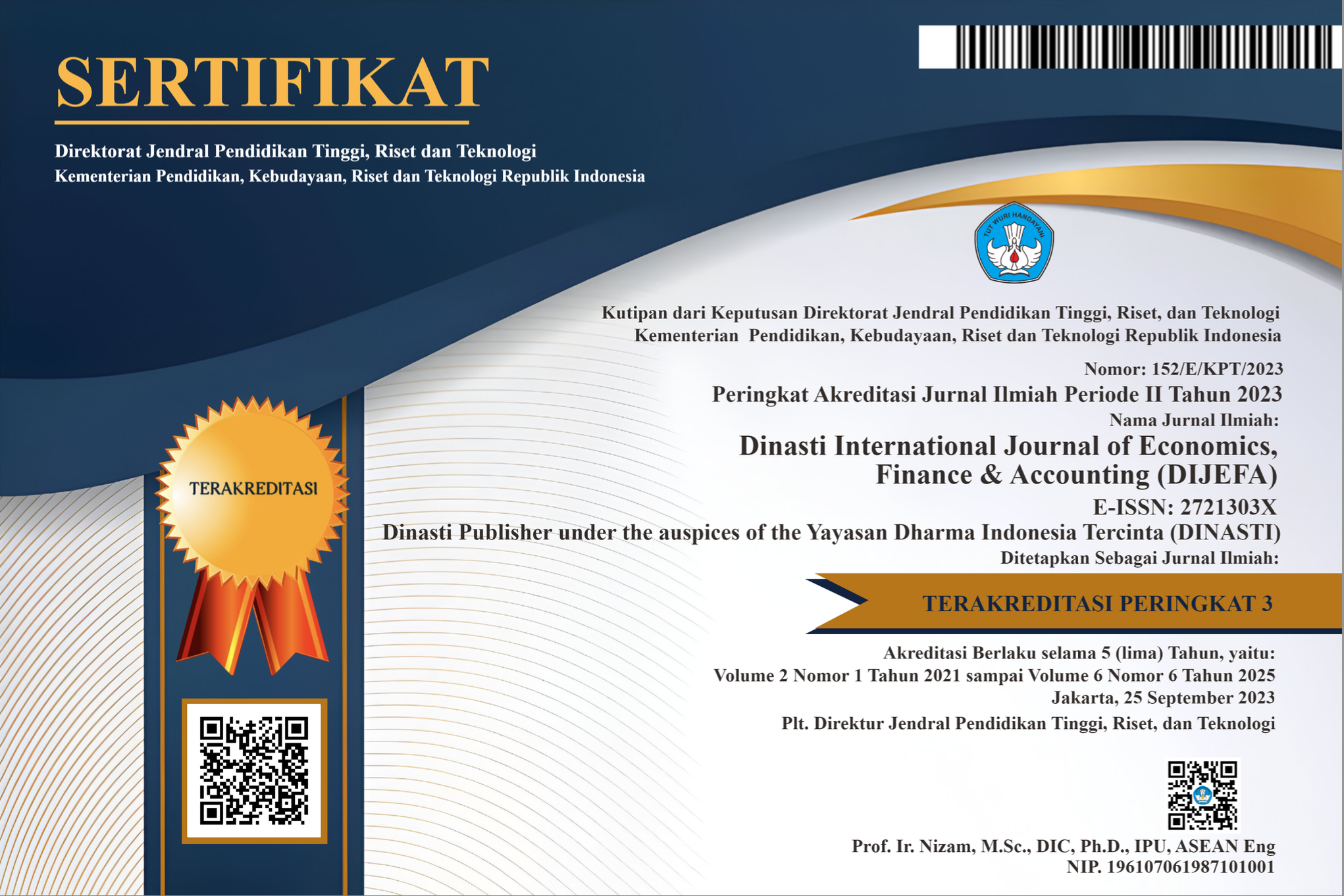The Effect of External Public Debt and State Sukuk (SBSN) On Indonesia's Economic Growth: An Autoregressive Distributed Lag Approach
DOI:
https://doi.org/10.38035/dijefa.v4i4.2024Keywords:
Economic Growth, External Public Debt, Government Sukuk/SBSNAbstract
Indonesia's external public debt continues to grow with a ratio of 30.1% of GDP. In the first quarter of 2023, Indonesia's external public debt reached 199.4 billion US dollars or equivalent to 3000 trillion rupiahs. This condition makes Indonesia a debtor country that depend on international creditor countries or institutions. In addition, state sukuk as an alternative to state financing with sharia guidelines also continues to grow, but its performance cannot be equal to external public debt as one of the pillars of Indonesia's economic growth. Therefore, this study is present to analyse the effect of government external public debt paired with state sukuk as an Islamic fiscal variable on Indonesia's economic growth. Moreover, this study also analyses the factors that influence the growth of Indonesia's external public debt. The sample used to analyse the effect of government external public debt and state sukuk on Indonesia's economic growth was taken from the first quarter of 2010 to the first quarter of 2023. This study uses Autoregressive Distributed Lag (ARDL) to find empirical finding of the model. The results of this study indicate that the external public debt variable in the long term has a significant negative effect on economic growth while the state sukuk variable in the long term has no effect on economic growth.
References
Ahmad, W., & Radzi, R. M. (2011). Sustainability of Sukuk and Conventional Bond During Financial Crisis: Malaysia’s Capital Market. Global Economy and Finance Journal, 4(2), pp. 33-45.
Akhtar, S., & Jahromi, M. (2015). Impact of The Global Financial Crisis on Islamic and Conventional Stocks and Bonds. Accounting and Finance, 57(3), pp. 623-655. https://doi.org/10.1111/acfi.12136.
Araar, M. (2014). Islamic Finance Based on Sukuk Approach: The Roadmap for Economic Development in Tunisia. Journal of Islamic Banking and Finance, 2(1), pp. 197-208.
Arnone, M., & Bandiera, L., & Presbitero, A. (2005). External Debt Sustainability: Theory and Empirical Evidence. The Open University.
Awan, A. G., & Qasim, H. (2020). Impact of External Debt on Economic Growth of Pakistan. Global Journal of Management, Social Sciences and Humanities. 6(1), pp. 30-61. https://orcid.org/0000-0001-5767-6229.
Benbekhti, S. E., Boulila, H., Benladghem, F., & Benbouziane, M. (2019). The Asymmetric Effect of Sukuk on Government Budget : Dealing with Deficit in Malaysia. Signifikan: Jurnal Ilmu Ekonomi. Vol. 8 (1): pp. 93-104. doi: http://dx.doi.org/10.15408/sjie.v8i1.8068.
Boumediene, A. (2015). Financing Government Budget Deficit as a Liquidity Risk Mitigation Tool for Islamic Banks: A Dynamic Approach. International Journal of Islamic and Middle Eastern Finance and Management, 8(3), pp. 329-348.
CNBC Indonesia. (November 2022). Utang Luar Negeri Terus Turun, RI Makin Jauh dari Krisis!, (online), (https://www.cnbcindonesia.com/market/20221120162448-17-389650/utang-luar-negeri-terus-turun-ri-makin-jauh-dari-krisis, diakses 21 April 2023).
Cohen, D., & Sachs, J. (1986). Growth and External Debt Under Risk of Debt Repudiation. European Economic Review, 30(3), pp. 529-560.
Datuk, B. (2014). Sukuk, Dimensi Baru Pembiayaan Pemerintah Untuk Pertumbuhan Ekonomi. Jurnal Riset Akuntansi dan Bisnis, 14(1).
Ehikioya, B., et al. (2020). Oil Price Fluctuations and Exchange Rate in Selected Sub-Saharan Africa countries: A Vector Error Correction Model Approach. International Journal of Energy Economics and Policy, 10, pp. 242-249. https://doi.org/10.32479/ijeep.9822.
Fasa, M. I. (2016). Sukuk: Teori dan Implementasi. Li Falah: Jurnal Studi Ekonomi dan Bisnis Islam, 1(1), pp. 80-94.
Gaies, B., & Nabi, M. S. (2019). Financial Openness and Growth in Developing Countries. Journal of Economic Integration, 34(3), pp. 426-464.
Kausar, S. W., Ali, R., & Khan, T. A. (2022). The Impact of Foreign Debt on the Economy of Pakistan. Global Economic Review, 7, pp. 10-19.
Kharusi, S. A. & Ada, M. S. (2018). External Debt and Economic Growth: The Case of Emerging Economy. Journal of Economic Integration, 33(1), pp. 1141~1157. http://dx.doi.org/10.11130/jei.2018.33.1.1141
Khodaparasti, R. B., & Mohammadpour, R. (2016). The Effect of External Debt on Real Economic Sector in Selected CESEE Countries. Economic, 18(43), pp. 548-556
Krugman, P. (1988). Financing vs. Forgiving a Debt Overhang. Journal of Development Economics, 29, pp. 253-268. https://doi.org/10.1016/0304-3878(88)90044-2
Kurniasih, E. P. (2021). The Effect of Foreign Debt on the Economic Growth. Jurnal Ekonomi Malaysia, 55(3), pp. 125 – 136. http://dx.doi.org/10.17576/JEM-2021-5503-09
Mack, A. R. (2001). Rethinking the dynamics of capital accumulation in colonial and post-colonial Indonesia: Production Regulation.
Malikov, A. (2017). How Do Sovereign Sukuk Impact on the Economic Growth of Developing Countries? An Analysis of the Infrastructure Sector. In V. Efendić, F. Hadžić, & H. Izhar (Eds.), Critical Issues and Challenges in Islamic Economics and Finance Development. Basingstoke, UK: Palgrave Macmillan.
Mankiw, N. G. (2006). The Macroeconomist as Scientist and Engineer. Journal Of Economic Perspectives, 20(4), pp. 29-46.
Rauf, A., & Khan, A. A. (2017). Impact of Foreign Debt on Economic Growth: Evidence From Pakistan. Asian Economic and Financial Review, 7(10), pp. 1005-1013, https://doi.org/10.18488/journal.aefr.2017.710.1005.1013
Rusydiana, A. S. (2016). The Comparison of Sukuk and Bond Absorption: Deficit Budget Financing in Indonesia. Tazkia Islamic Finance and Business Review, 10(2).
Sachs, J. (1989). The Debt Overhang of Developing Countries in Debt Stabilization and Development: Essay in Memory of Carlos Diaz Alejandro, ed. by Calvo, A. Guillermo, and others. Basil Blackwell: Oxford, pp. 80-102.
Safwat, A., Salah, A., & Sherif, M. E. (2021). The Impact of Total Foreign Debt on the Economic Growth of Egypt (1980-2018). Open Journal of Social Sciences, 9, pp. 130-151. https://doi.org/10.4236/jss.2021.910010
Sari, V. K. (2022). Debt and Economic Growth: The Case of Indonesia. JDE (Journal of Developing Economies), 7(2), pp. 198-207
Satya, V. E. (2016). Analisis Kebijakan Pengelolaan Utang Negara: Manajemen Utang Pemerintah dan Permasalahannya. Kajian, 20(1), pp. 59-74.
Setianingsih, L., & Widyastuti, E. (2020). Does Sukuk, Domestic Investment, Foreign Investment and Inflation Contribute to Economic Growth in Indonesia. Jurnal Ekonomi Syariah Teori dan Terapan, 7(12), pp. 2375-2384.
Suidarma, I. M., & Yasa, I. N. A. (2021). The Contribution of External Debt to Economic Growth: An Empirical Investigation in Indonesia. Journal of Asian Finance, Economics and Business, 8(10), pp. 0011–0017. https://doi.org/10.13106/jafeb.2021.vol8.no10.0011
Sukirno, S. (2019). Makroekonomi: Teori Pengantar. Jakarta: Raja Grafindo Persada.
Yuliani, I., Qizam, I., Nugroho, A., & Mu’arrif, Z. I. (2022). The Impact of Sukuk on the Country’s Economic Growth with Country Governance as a Moderating Variable. Al-Uqud: Journal of Islamic Economics, 6(1), pp. 112–123. https://doi.org/10.26740/aluqud.v6n1.p112-123
Downloads
Published
How to Cite
Issue
Section
License
Authors who publish their manuscripts in this journal agree to the following conditions:
- The copyright on each article belongs to the author(s).
- The author acknowledges that the Dinasti International Journal of Economics, Finance & Accounting (DIJEFA) has the right to be the first to publish with a Creative Commons Attribution 4.0 International license (Attribution 4.0 International (CC BY 4.0).
- Authors can submit articles separately, arrange for the non-exclusive distribution of manuscripts that have been published in this journal into other versions (e.g., sent to the author's institutional repository, publication into books, etc.), by acknowledging that the manuscript has been published for the first time in the Dinasti International Journal of Economics, Finance & Accounting (DIJEFA).


























































